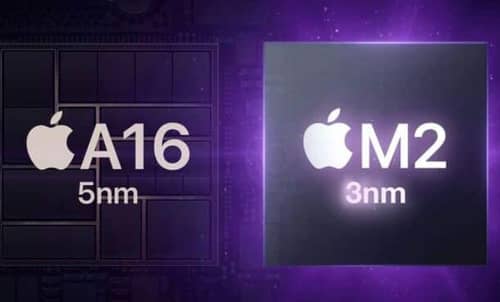 |
| Apple manufactures A16 processor based on 5nm technology |
Apple is said to be making the A16 chip for the upcoming iPhone using the same process as the A15 Bionic chip used in the iPhone 13, and the company offers an even bigger leap in performance for the M2 chip, which will be used in next-generation Macs. .
Meanwhile, according to a leaker named ShrimpApplePro, the company is working on a different version of the M1 chip that uses more powerful cores than the A15 Bionic chip.
The information shared by the leaker revealed Apple's plans for the upcoming A16 and M2 chipsets, as well as a new version of the M1 chipset series.
Like the A14, A15 and M1 chips, the A16 chip is based on TSMC's 5nm manufacturing process.
It was not clear from previous reports if the A16 chip would be manufactured using TSMC's advanced 4nm process.
A report by DigiTimes claims that Apple plans to use the Taiwan semiconductor maker's 4nm N4P manufacturing process. But N4P is an updated version of the 3rd generation 5nm process technology.
On the other hand, the leaker claims that the A16 chip uses the TSMC N5P process. This indicates that the A16 chip may not be a significant upgrade as previously thought.
The improvement in the A16 chip is said to come from small improvements in the CPU, GPU and memory.
According to a report by analyst Ming-Chi Kuo, the leaker claims that the A16 chip contains LPDDR 5 memory.
Compared to LPDDR 4X memory paired with the A15 chip in iPhone 13, LPDDR 5 memory is up to 1.5 times faster and 30% more energy efficient.
Apparently, the M2 chip could be the first Apple chip made in the 3nm process, bypassing the entire 4nm process. The M2 chip is Apple's first custom ARMv9 processor.
Apple is developing another version of the M1 chip
Apple is also working on another version of the M1 that includes an updated kernel. The M1, M1 Pro, M1 Max and M1 Ultra chips use energy-saving Icestorm cores and high-performance Firestorm cores, such as the A14 Bionic chip.
Instead, the new version of the M1 is based on the A15 Bionic. It contains an energy-saving Blizzard core and a powerful Avalanche core.
The chip could be introduced in the next generation Mac Pro, which the company specifically announced earlier this year.
The M1 Ultra is a dual version of the M1 Max with a 20-core CPU and 64-core GPU, Apple's most powerful chip to date.
Apple is believed to be developing a more powerful chip than the M1 Ultra to power the first Mac Pro based on its processor. The M1 Ultra in Mac Studio is faster than the 28-core Intel Xeon chip. Therefore, Mac Pro requires higher performance.
And if the new M1 wasn't designed for the Mac Pro, the new chip could be a variant of the standard M1 chip.
Kuo previously said that the 2022 MacBook Air will keep the M1 chip instead of using the M2 chip.
As such, the new M1 is likely to be an entry-level model. It has nothing to do with high-end Mac Pro versions with Apple processors.
The introduction of hardware with a new version of the standard M1 chip saves the company time before launching a Mac with the M2 chip.
According to reports, the iPhone 14 Pro and iPhone 14 Pro Max have an A16 chip. Although the iPhone 14 and iPhone 14 Max still use the A15 Bionic chip.
Later this year, the redesigned MacBook Air may also include an M2 chip. Before it comes to the new Macs, there could be the next generation iPad Pro.